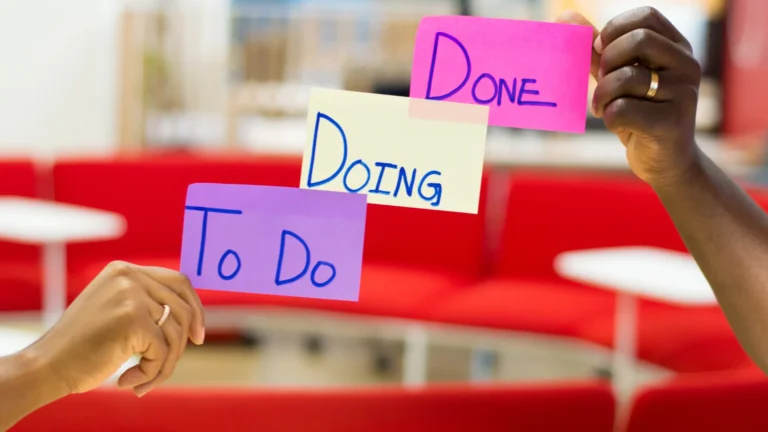Maybe you are an established up-and-coming company or you want to start a business but you just don’t have any ideas how to further develop your business or how to start? This is where brainstorming comes in – it’s a great way to get the creative juices flowing and create a comfortable space where you can come up with lots of new ideas at once, and after a good brainstorm you’re well on your way to your own profitable business.
In this blog post you will find different brainstorming techniques to help you avoid these common brainstorming problems and bring your team together to come up with creative ideas.
What is brainstorming?
Any activity in which a person collects general ideas about a topic or task; either in groups or individually, without limiting the quality of the ideas. Once all ideas have been collected and written down, an evaluation takes place and a decision is made as to which of them should be pursued further.
Brainstorming is a situation in which a group of people come together to construct and develop new ideas about a specific area of interest. By applying rules that break down inhibitions, participants can think more freely and move into new areas of thought, generating numerous new ideas and solutions. Participants call out their ideas as they come to them, and then build on each other’s ideas. All creative ideas are noted and not criticized. The ideas are only evaluated at the end of the brainstorming session. Brainstorming is also referred to as a creative technique.
Why do we brainstorm?
It helps us to be creative. Also, if we do it in a group of people, it’s very informal and encourages participation. And when we do it in a group of people, the ideas we can explore become richer because we all have different backgrounds, different experiences and different cultures.
Brainstorming is also a great way to strengthen team spirit. Sometimes with a new team and sometimes even with an old team. You just have to get them on the same page. This way they can find a solution together, and that can be quite fun.
The fathers of the brainstorming method
According to Alex Osborn , credited with inventing creative problem solving and brainstorming, brainstorming employs a specific set of rules and techniques that encourage and trigger new ideas related to specific areas of interest.
- Brain writing
- brainstorming
- Online brainstorming
- Rapid brainstorming and collection of ideas
- Round robin brainstorming
- starburst
- stepladder technique
Charles Hutchison Clark took up Alex Osborn’s brainstorming idea and wrote a standard work about it. Among other things, Clark made the term “manslaughter argument” and “killer phrase” famous. He also coined the terms “snow shovel question” (general questions to which the answers are usually also very general and therefore unhelpful) and “spade questions” (questions that go straight to the heart of a problem). Both will be used today especially for brainstorming.
Ways to improve brainstorming when generating ideas
In general, brainstorming is about writing down an unfiltered and large number of ideas in order to later focus on the ideas that best fit a problem. Done right, it can generate and develop ideas and clever solutions, and encourage lateral thinking that is often lost in a structured analytical approach.
To get the best results from your brainstorms, consider these factors:
More is more
When generating ideas for your task, everything counts, even if most ideas may seem ridiculous. The purpose of the exercise is to change our mindset to go beyond the obvious and then into uncharted territory. Many ideas are not used, but they are crucial to the process.
Don’t judge
The time for criticism will come, but hasty judgments can lead to withdrawal from the process. Creative thinking flows when we are relaxed and comfortable. It is important not to judge ideas. This is not helpful, which is especially important in group brainstorming.
Keep the fun
It’s no surprise that fun and creativity go hand in hand. Pressure kills the creative ideas by reducing the ideas to what is safe. Because that is a sign of convenience and enables better ideas.
Mind mapping
If you’re wondering how to manage all of these ideas, consider mind mapping. Mind mapping focuses on the problem or concept and destroys the ideas in the surrounding areas. Further ideas are then linked with their own, until a card with interconnected solutions and topics emerges.
By following these tips, you can achieve the most creative results and have a great time doing it.
Why can brainstorming fail?
There are several factors that can cause brainstorming sessions to fail, but here are some of the most common reasons why a brainstorming session fails:
There are basically two possible outcomes for a brainstorming session. One where the team goes home feeling energized, accomplished, and excited for the next steps. Or the session is perceived as unproductive, repetitive or negative. There are several factors that can cause brainstorming sessions to fail, but here are some of the most common reasons why brainstorming sessions fail:
#1 Unbalanced Conversation
Extroverted personalities and quick thinkers dominate the discourse and leave little room for contributions from other colleagues.
#2 Crickets
When this happens, participants are unprepared, resulting in an hour of agonizing silence or, worse, a session that is broken up to put everyone out of their predicament.
#No. 3 anchoring
Participants in a brainstorming session limit themselves to a few initial ideas, thereby limiting the scope for further innovative and creative ideas.
5 Creative Brainstorming Techniques
Group Brainstorming Techniques
1. Brain writing
With this brainstorming technique, the brainstorming exercise is divided into several rounds. Each participant writes down at least three ideas on the topic within 5 minutes in each round. So 3 ideas per participant in 5 minutes. After the first round, everyone exchanges a piece of paper with the participant on their right or left, who then complements the ideas with bullet points for creative strategies. After a few minutes, the note is passed again until it has circled the entire table. Once the ideas have gone through the circle, the group decides which ideas to pursue further. This technique can help avoid two of the most common brainstorming pitfalls: unbalanced conversations and anchoring. Brainwriting ensures everyone has an opportunity to contribute and avoids favoring the first idea. It’s a wonderful brainstorming technique. It can give you as many ideas as you need.
2. Starburst
Starbursting is a complete, systematic questioning exercise that is helpful in exploring new ideas. In a starburst brainstorm, we start with the main idea and then form a six-pointed star around it. Each point of the star represents a question – who, what, when, where, why and how. For example, if a co-worker suggests a new section in your online bookstore, a question might be, “Who is the target customer?” Let’s assume the answer is: students. If you want to target your promotions precisely to the target audience, your next question might be: What kind of students? The answer to this question might be something like: students who need research papers, etc.
A systematic question like this would help focus the marketing strategy. The next possible question could be: When is the right time to introduce this new feature? Because starbursting focuses on questions rather than answers, it encourages the group to explore a topic from all angles. Presenting ideas in this way saves whoever came up with the idea from having to defend it or figure out how to implement it themselves.
3. Reverse brainstorming
Reverse brainstorming, also known as negative brainstorming, is a technique that turns the traditional brainstorming process on its head. Instead of asking for brilliant suggestions on how to improve a process or a goal, ask the team to think of a way to make achieving a process goal impossible. They asked the team to let any spent negative thoughts bubble to the surface. These negative ideas provide useful information about what isn’t working in the product.
The easiest way to illustrate reverse brainstorming is to compare it to the traditional brainstorming we normally use.
A typical brainstorming question might be: How can we improve customer service? A related reverse brainstorming question would be: How can we make customer service so bad that everyone walks away from it?
I created a video detailing the reverse brainstorming process. You can find the link in this corner or in the video description if you watch the video on YouTube.
4th step ladder
In the ladder brainstorming technique, a facilitator first introduces the brainstorming topic and then asks everyone but two people to leave the room. The facilitator then asks these two people to come up with ideas within a limited amount of time. After they finish writing ideas, one more person is allowed to enter the room. This new person is asked to share their ideas before discussing the ideas and suggestions already developed. Each person who comes from outside returns to the room one by one. They first discuss their own ideas before learning about others’ ideas.
The ladder method usually takes some time, so if the group is too large, you might want to use a less complicated method. Steven Rogelberg, Janet Barnes-Farrell and Charles Lowe developed the ladder method in 1992 to encourage all group members to contribute their own ideas and not let others influence them.
This technique helps with unbalanced conversations. It encourages a wider range of ideas, keeps people from hiding within the group, and protects people from being trampled and dominated by the stronger, louder members of the brainstorming group.
5. Role storming
In the district, participants must pay well for a character who is not in the room. This can be a boss, a fictional character or a well-known person. And then the participants talk about how that person would handle a certain situation or would look at a certain situation. For example, you can ask how Elon Musk would handle this situation? This question may seem ridiculous, but putting yourself in the shoes of others can be a creative way of helping you and your team. When team members are embarrassed or afraid to share innovative ideas, they are more willing to do so when their ideas are shared with someone else’s name, like in this case Elon Musk. This brainstorming also removes some of the obstacles that typically stifle creative thinking, such as: B. the budget.
Brainstorming is an incredible idea for generating new ideas, identifying problems and developing solutions, but it’s only as good as the participants and the facilitator. Regardless of how you prepare, distractions, personal disputes, nervousness, or just plain boredom can get in the way of a successful brainstorming session. When that happens, you’ll be lucky if you have a collection of awesome brainstorming ideas to help move the process forward.
How do you brainstorm?
The preparation for the brainstorming
We can brainstorm ourselves or with a group of people without you thinking about brainstorming.
For example, every Friday you brainstorm the shopping list and think about what you have and what you don’t have. Sometimes you also brainstorm about the ingredients or about the movie you want to see.
If there is a group of people, they can be friends, colleagues, students, peers. You have to get yourself in the right frame of mind to brainstorm. Some people call this “clearing your head”, some go for a walk or take a break, shower and then think about different ideas with a fresh mind.
Some people carry around a journal where they write down their random thoughts based on where they are, and many of us have a smartphone. So it’s easy to write a short SMS or message to yourself, or you can even turn on the recorder and just talk to your smartphone. You can do anything that will lift your creative spirit.
Group brainstorming sessions
As previously mentioned, as a group of people we always have a variety of backgrounds, cultures and experiences to draw from. And that is really a very good idea generation technique. And you can get very creative.
Another thing that helps people get in the mood to brainstorm is telling them that the decision makers are in the room. That’s very good, especially in the world of work. If you know exactly when you come up with the solution that those responsible will say yes or no. Because then you can really pull yourself together and do something. We all have normal routines and normal schedules and it really helps us to get out of this situation to come up with creative and diverse ideas.
Preparatory work: preparing ideas
When you brainstorm, you should prepare.
The location is the first thing to do. Sometimes you need to reserve it because you are bringing a lot of people or team members together to brainstorm (group brainstorming) and of course when it’s just about yourself (individual brainstorming) you don’t need to reserve it, but you should consider where to go
Next you need to make sure you have the right people with you. If you are or aren’t and want to bring in other people to brainstorm, make sure you have the right professionals to help you solve your problem. The more complex the problem, the more time you should give them to think about it.
Finally, you need someone to lead the discussion. Of course, you don’t need someone to lead the discussion if it’s an individual brainstorm, but if you’re conducting a group brainstorm or discussion, make sure everyone participates and you have an opportunity to ask from each individual Listen. You can also make it fun.
Brainstorming tools
Individual ideas
Perhaps you are traveling by car, perhaps you want to find your place of thought in a different place than where you normally are. They want to be able to write down these ideas.
Brain Dump
Some people do this on Friday afternoon or maybe Monday morning. It’s a good thing when you sit down and think about everything that’s on your mind and just start writing it down. This is a good way to prioritize for the next week or look at all the things you’ve been thinking about. You never know what you might come up with.
Oral or in writing
The brainstorming can be done in writing or orally. Oral brainstorms are great. People can come up with a lot of ideas when you put them together, but sometimes people have different traits, different personalities, and it’s easier for them to write down their ideas.
Stepladder
You present a problem to a group of people, divide the group into pairs, and have them discuss ideas. Come up with solutions to a problem. You give them about a minute, then add a third person to your group. This person brings in the ideas from the other group, and you discuss the ideas that you have already discussed. And sometimes even more creative ideas emerge. Then add a fourth person to the group, then the fifth, then the sixth, and so on until you have the whole group together.
This is a great way to ensure everyone in the room has a voice in the discussion, and it’s a great way to get ideas from different people.









